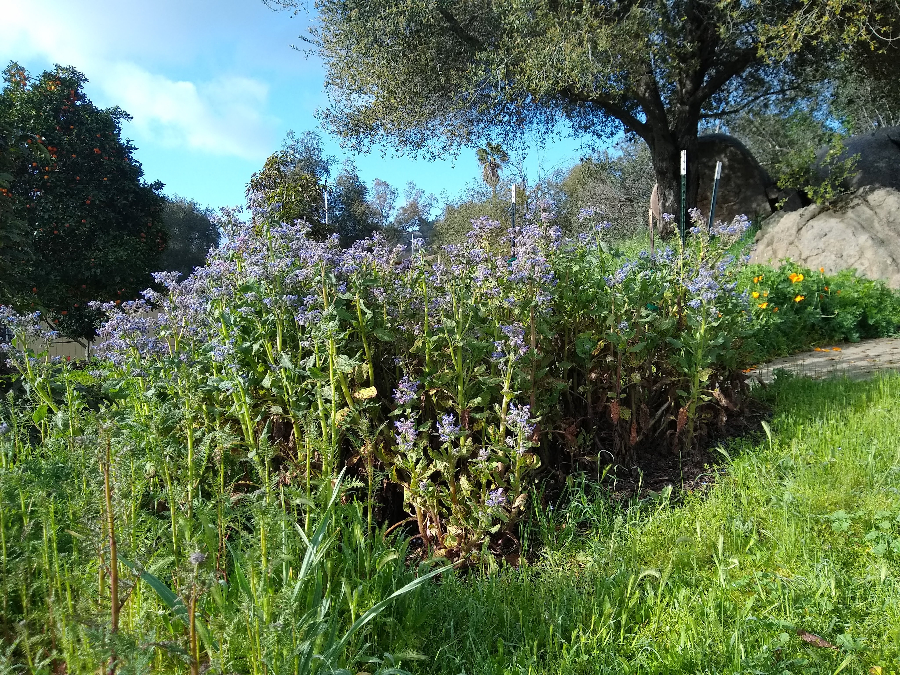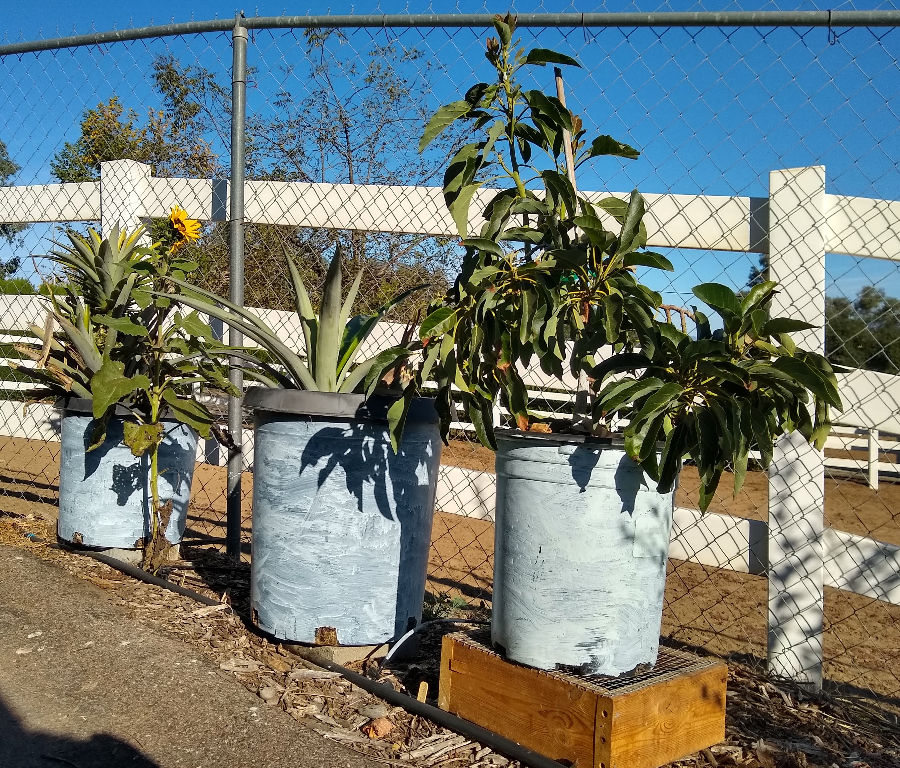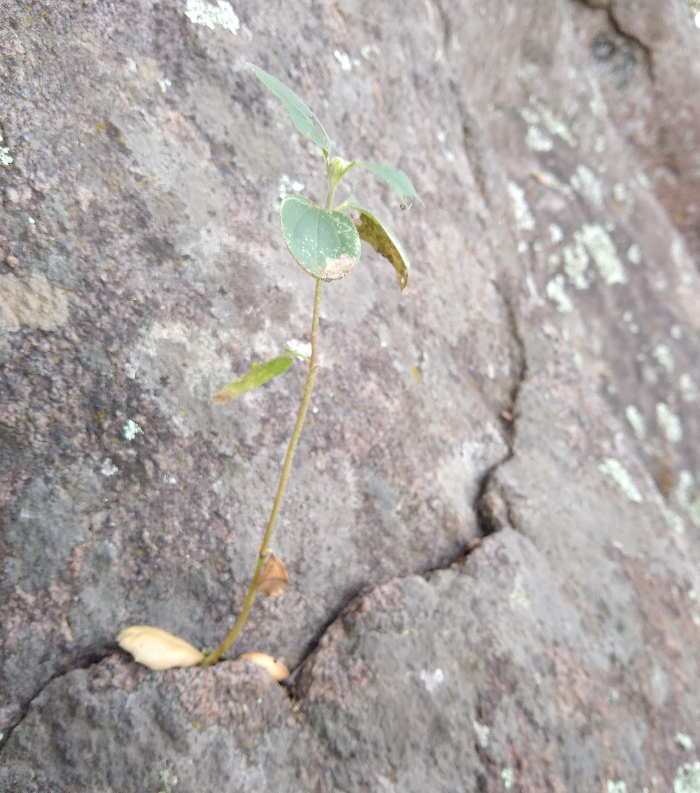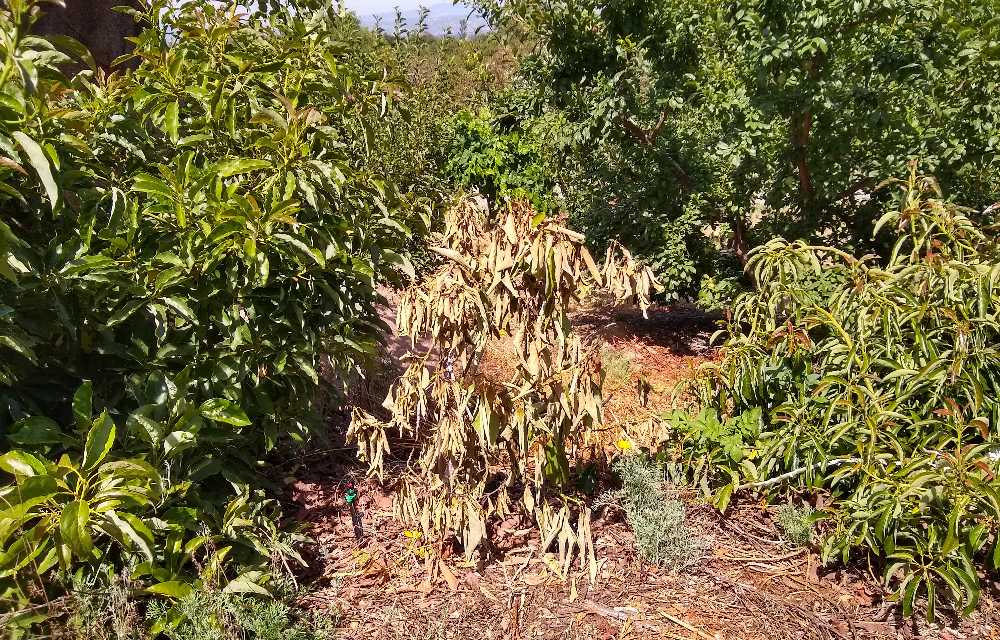First I planted a Granny Smith apple. Second I planted a Sharwil avocado. Then I planted another Sharwil avocado. Finally I planted a Flavor Grenade pluot in this spot, but it too died. It was then that I realized it was not me killing these trees, it was this location in my yard. It was a dead spot.
(Above is the second Sharwil avocado tree after I transplanted it to try to save it; nevertheless, soon after transplanting, it completed its decline.)
Why?
What made this spot a tree killer? Initially, I considered many possible causes. It was near a large oak tree so maybe the oak roots were sucking the soil dry. I increased irrigation. I found gopher tunnels so maybe gophers were feeding on roots. I collapsed tunnels and trapped assiduously in the area.
But growth in all of the trees in this spot had been slow compared to similar trees I had planted elsewhere in my yard, and the leaves on the trees in this spot didn’t get as big nor as deeply and uniformly green.
I began to suspect toxicity in the dirt.
History
Memories came back: When we bought this place ten years ago I had found some old bottles of Roundup and pesticides in the garage. I also found the frame of an old three wheeler up on the hill; it had wheels but no tires and no engine. And a neighbor once casually mentioned to me that she had been told that there was a Toyota engine buried somewhere on the property.
The previous owners might have needed a place to dump motor oil or pesticide or paint. They might have dumped it where I, twenty years later, planted tree after tree after tree.
Soil test
I don’t know. I’ve thought about sending a sample of the soil from this spot for testing but it’s expensive to test soil for general contamination. (It’s cheaper to test for a single, specific contaminant.)
Plant tougher plants
But weeds grew in the dead spot. So whatever the problem, it wasn’t a problem for all plants. I gave up on fruit trees and tried tougher, shorter-lived plants — flowers mostly — and they have grown fine. At the moment there are sunflowers, borage, phacelia tanacetifolia, and poppies, alive in the dead spot.

Other spots
I have one other dead spot in my yard. There I have switched to growing plants in pots.

And I have a few other spots in my yard where plants have never grown well. They’re not dead spots but they are struggle spots. In those areas, I’ve usually found improved results by piling up compost and planting on mounds (as explained in this post).
Do you have dead spots or struggle spots?
If you can relate, and there are parts of your yard that don’t grow plants as well as others, consider the same options:
1. Grow different kinds of plants (if a mango tree fails, try a mandarin; if the mandarin fails, try some tough flowers or natives);
2. Mound up the area with new soil or compost (or if practical, remove some of the soil and replace it);
3. Or grow in pots in that spot.
There are many reasons that a specific plant won’t thrive in a particular patch of dirt. The soil pH might be too high or low for that species, the soil might be too shallow, etc. But if you suspect toxicity, especially if you have a hunch about which contaminant to look for, then a soil test might be worth the money and peace of mind.
Regardless, don’t give up. There are plants that will grow in almost anything.

All of my Yard Posts are listed and linked here.
I’m able to continue writing and keep ads off these pages only through your support.




Most pesticides break down pretty quickly in the soil- my money is on oil or some other oil-based contaminant.
Also, Roundup doesn’t “travel” in the ground. It needs to be applied to the plant’s leaf system. Oil and oil-based paint probably a good culprit. Another is a possible parasite.
As an experiment, take a few shovels of the dirt, put it into a large pot, move it away from the area, drench it with a vinegar solution, let it dry out then flush it with plain water and see if you can get a volunteer plant to grow in it.
You’re probably too cold in the winter for a papaya to survive but I’d suggest planting one there to see what happens. Someone once told me to find the worst place in your yard where nothing will grow and plant a papaya. I did and it’s lived at least 7 years, survived the crazy rains of last year, and some pretty cold weather.
I have what might be a dead spot. I planted an avocado years back (forgot the variety) It took two years to die. Stewart 3 years ago. It was doing OK. I plant in a raised bed bordered by 2×10’s. In winter i cover the box with strong black plastic to keep a few degrees warmer and to keep the heavy rains off. It took the winter pretty good lost about half its leaves, but came back strong. Got bushy and bright green, but didn’t gain any length.. By the end of summer it hadn’t grown and the plant looked sickly. My 5 year Hass had lost nearly all leaves but also came back strong. the Little Cado lost some leaves but for the most part was unfazed as was my Mexicola. I replanted the Stewart and it soon died. I’m thinking nematodes. Other possibilities, Cats using the ground for a litter box, but i covered most of the area with wire fencing. About ten feet away on neighbors property is a huge 60 foot plum. Maybe roots? But i hadn’t encountered any when i first planted. So I have just transplanted a dwarf Peach into the spot. If it dies, I’ll try just growing flowers to attract bees for the Avocados doing well.